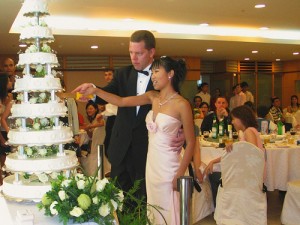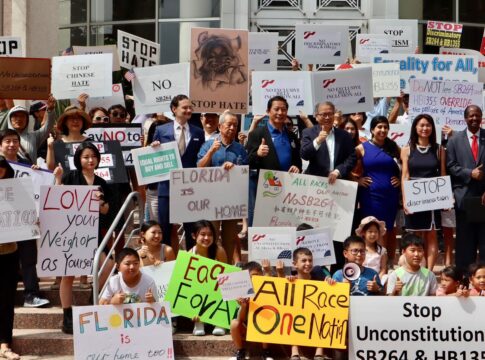Editor’s Note: The following is a question and answer between reporter Karen Ye and Dr. Larry Hajime Shinagawa, Executive Director of New World Research Institute, a non-profit think tank focusing on research on new immigrants to the United States. Among his research areas are intermarriage, multiracial identity, and Asian American culture and community. He is former director of Asian American Studies at the University of Maryland at College Park and director of the Center for the Study of Culture, Race, and Ethnicity and Associate Professor of the Sociology Department of Ithaca College. Shinagawa makes the case that we need to go beyond color-blindness to understand intermarriage among Chinese Americans. Those with opposing views are invited to submit them in the comments section. You may also propose writing a blog in response to this story by sending your pitch to [email protected] (photo by Anthony Van Dyck).
Q: People say “love sees no color,” how do you feel about it?
LATEST STORIES
A: Not true. When I wrote my dissertation on intermarriage among Asian Americans, I interviewed six dozen interracial couples. When they were with their significant other, they said, “I don’t see color. I just see him/her.” But when I talked to them individually, they discounted the narrative of color blindness and said it indeed played a major role, but one that they tried to overcome.
Q: What do you think that tells us?
A: That interracial relationships and interracial marriages are anything but color-blind. Yes, there is love, but that love is tinged and affected by the history of colonialism, skin color hierarchy, White racial privilege, unequal economic opportunity and by racist/sexist imageries that define the politics of sexual desire and acceptability.
Q: So what are the patterns today?
A: Very few Chinese American men intermarry, and when they do, it is in the 2nd generation and beyond, overwhelmingly with white and Asian females. Every generation of Chinese American women has a substantially greater tendency to intermarry into the white population and other Asians. Very few marry racial minority men.
Q: Doesn’t that show that Chinese Americans prefer to marry whites?
A: Not really. If we control for population size, we get the probability or “preference” to marry someone. The figures show that Chinese American men and women are significantly more willing to marry another Chinese or Asian than a white.
Q: Why are Chinese females much more likely to marry into other populations than Chinese males?
A: Women continue to be affected by patriarchy and racial hierarchy; men and higher racial status men in particular hold more power. Thus, racial minority women tend to “marry up” to gain greater social status, especially if their children can adopt their father’s status.
The historically shaped imagery of Chinese American women as sexually alluring, submissive and family-oriented China dolls with lighter skin color plays a major role in making them desirable to other non-Asian men.
Chinese American men have high economic and educational status, but still have much lower social and racial status and negative stereotypes affecting their desirability and acceptability as marriage partners.
Q: But why are there more Chinese men intermarrying white women now?
A: Because Chinese American men’s economic and educational statuses are much higher than most white men, which mitigates for their lower racial status.
Q: Statistics show that white people seem to prefer marrying Asians than blacks. Why?
A: Unfortunately, we continue to live in a world where race, skin color, colonial history, economic inequality, sexual imagery based on racial stereotypes, and immigration status continue to affect how we value or give worth to an individual. Asians “benefit” from being more acceptable to whites as marital partners.
Q: I heard that if a child is white and Asian, he/she is considered white. But if a child is white and black, he/she is classified as black. Why?
A: Since the Treaty of Guadalupe Hidalgo (1848), light-skinned racial minority women have been given the possibility of having their children gain the racial status of their child’s father, under certain conditions. When a child is white and Asian, usually the child has been deemed white. Historically, this is called “The Reverse One Drop Rule” or more colloquially, “if you are light, you’re white.” Complementing this rule was the “One Drop Rule,” passed during the 1600s by American colonists and continuing to this day. It was originally legislated to discourage white women from marrying black men. The concept is that if you were one drop black, you were deemed black, which, in the past, was equivalent to that of a slave.
Q: What made you start studying all this?
A: Since I came to America at the age of seven, I quickly became exposed to racism and discrimination, interracial relationships, intermarriage and multiracial identity. As I grew older, I noticed that my half-Japanese half-white sister was treated as exotically beautiful, while I was treated as a chink or slant-eye even though we came from the same family. Once I entered college, I noticed that many Asian American men bitterly complained about Asian American women preferring to go out with white men. I wanted to study intermarriage more academically, rather than to rely upon unfounded speculation or biased opinion.
Q: In the future, do you think the Asian population will disappear and assimilate into the white population?
A: Absolutely not. In the past 30 years, racial minorities have achieved a critical mass where they are seen and perceived as separate communities. Nowadays, these communities are large enough to develop and maintain their own social networks, mores, employment systems, and residential patterns. Thus, Asian Americans are “self-segregating” themselves. Most Asian Americans tend to marry people with the same or similar racial background.









